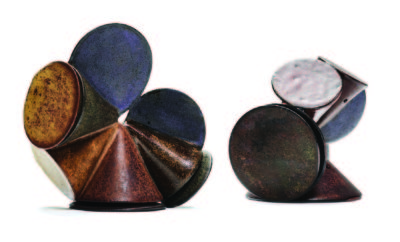 Magdalena Suarez Frimkess, untitled, 2017. Photo by Adam Kremer, Courtesy of the artist and kaufmann repetto Milan / New York
Magdalena Suarez Frimkess, untitled, 2017. Photo by Adam Kremer, Courtesy of the artist and kaufmann repetto Milan / New York
Exhibition
Magdalena Suarez Frimkess’s Ceramics Front and Center at the Kaufmann Repetto Gallery
“Serious and funny at the same time”—that’s how Magdalena Suarez Frimkess has described her philosophy on art, and you can see this in her handsomely painted ceramic box depicting a lively underwater sea world with smiling and grimacing fish, upright crabs, seahorses, buoyant eel grass, and a giant speckled octopus with curling pink arms. Kaufmann Repetto in New York has staged an exhibition, on view until October 21, showing over fifty of the artist’s small objects, including pots, cups, pitchers, and modeled figures—all of it easy to hold in your hands. The work spans most of her career, starting with a 1970s Kama Sutra tile, mischievously dedicated to Hugh Heffner (as she inscribed it: “Happy 50 HEF”), and finishing with a doll-like sculpted horse with saddle and bridle, which she made this past spring.
Suarez Frimkess is eighty-eight years old and still working every day. She was born in Venezuela and lived as a young woman in Chile where she took courses in painting and sculpture. She met her husband, the ceramic artist Michael Frimkess, when she came to the United States on a fellowship in the early 1960s, and for many years, after he developed multiple sclerosis, she worked jointly with him, decorating the crisp surfaces of the pots he turned on a wheel using the little-known technique of dry throwing. A few of their collaborative pieces are on view in the show, including an especially lovely dish with three painted, frilled carnations on the round, flat center. But the show is dominated by her own handmade work with wobbly lids and tattered handles and spouts; ragged along the edges, the uneven surfaces prickly from grog and indented with imprints of the potter’s hands. These pieces, rugged and tactile, have the expressive and sculptural freedom of children’s pottery, and at the same time, the decoration is often arduously painted with a technique that’s been compared to cloisonné. Artistically, Suarez Frimkess is fearless, pulling in everything—Pre-Columbian art, Delftware, Japanese block prints, comic book characters, and private landscapes from memory—for her subject matter.

Magdalena Suarez Frimkess, Untitled, 1999. Photo by Adam Kremer, Courtesy of the artist and kaufmann repetto Milan / New York
One of the highlights of the show is a ceramic water pitcher that stands upright, resembling a tubular figure with a bent arm on its hip. She has decorated the surface with a drawing of her young daughter in a play dress and wearing pigtails, standing in the grass, surrounded by trees and agave. The bold juxtaposition of the indigo background against the red of the little girl’s dress and the green of the garden brings to mind the color palette of the artist’s youth in Latin America. At the same time, the line drawing is fine and detailed, conveying a strength of character in the little girl’s grin and solid stance—an homage to the truthfulness and what has been called the innocent eye of childhood.












